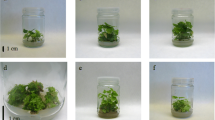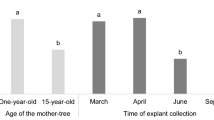Abstract
Factors affecting micropropagation efficiency of 32 selections of Rubus, including the pre-treatment and initiation culture stages, were investigated. Chilling at 4°C for 6 weeks as a pre-treatment significantly promoted in vitro initiation culture; up to 65% of initiation cultures post chilling were successful. The cytokinin 6-benzyladenine (BA) was the most effective of the three tested for promotion of multiple shoot development in culture, with an average of three to seven shoots or plantlets developed from each single node. Alternating the concentration of BA between 4.44 and 13.31 μM from sub-culture to sub-culture improved recalcitrant Rubus micropropagation, and reduced the problems associated with long-term culture in the presence of high concentrations of BA. Reduction of the strength of macro- and micro-elements in the basal medium from half to one-third, with addition of 0.49 μM indole-3-butyric acid and 0.05% activated charcoal, and placing the cultures under reduced light intensity (17 μmol m−2 s−1), was found to alleviate chlorosis and improve micropropagation with high quality Rubus plantlets. Response to in vitro culture differed greatly and consequently different methods of micropropagation were required by different genotypes. From these selections, three types of micropropagation including micro-cutting, micro-shoots and multi-shoots were observed, and their efficiency was characterized.






Similar content being viewed by others
Abbreviations
- BA:
-
6-Benzyladenine
- IBA:
-
Indole-3-butyric acid
- AC:
-
Activated charcoal
References
Anderson WC (1980) Tissue culture propagation of red and black raspberry, Rubus idaeus and R. occidentalis. Acta Hort 112:13–20
Bobrowski VL, Mello-Farias PC, Peters JA (1996) Micropropagation of blackberries (Rubus sp.) cultivars. Rev Bras Agrociéncia 2:17–20
Broome OC, Zimmerman RH (1978) In vitro propagation of blackberry. HortSci 13:151–153
Carew JG, Gillespie T, White J, Wainwright H, Brennan R, Battey NH (2000) The control of the annual growth cycle in raspberry. J Hort Sci Biotechnol 75:495–503
Donnelly DJ, Daubeny HA (1986) Tissue culture of Rubus species. Acta Hort 183:305–314
Gajdošová A, Ostrolucká MG, Libiaková G, Ondrušková E, Šimala D (2006) Microclonal propagation of Vaccinium sp. and Rubus sp. and detection of genetic variability in culture in vitro. J Fruit Ornam Plant Res 14:103–119
Gonzalez MV, Lopez M, Valdes AE, Ordas RJ (2000) Micropropagation of three berry fruit species using nodal segments from field-grown plants. Ann Appl Biol 137:73–78
Harper PC (1978) Tissue culture propagation of blackberry and tayberry. Hort Res 18:141–143
James DJ, Knight VH, Thurbon IJ (1980) Micropropagation of red raspberry and the influence of phloroglucinol. Sci Hort 12:313–319
Jennings DJ (1988) Raspberries and blackberries: their breeding, diseases and growth. Academic Press, London
McGhie TK, Hall HK, Ainge GD, Mowat AD (2002) Breeding Rubus cultivars for high anthocyanin content and high antioxidant capacity. Acta Hort 585:495–500
McPheeters KD, Skirvin RM, Hall HK (1988) Brambles (Rubus spp.). In: Bajaj YPS (ed) Biotechnology in agriculture and forestry, Vol 6: Crops ΙΙ. Springer, Berlin, pp 104–123
Murashige T, Tucker DPH. (1969) Growth factor requirements of citrus tissue culture. In: Chapmen HD (ed) Proc First Inter Citrus Sym, Vol 3, Riverside, 1151–1161
Pelto MC, Clark JR (2000) In vitro shoot tip culture of Rubus, part 1: review. Small Fruits Rev 1:69–82
Reed BM (1990) Multiplication of Rubus germplasm in vitro: a screen of 256 accessions. Fruit Var J 44:141–148
Seeram NP, Adams LS, Zhang Y, Lee R, Sand D, Scheuller HS, Heber D (2006) Blackberry, black raspberry, blueberry, cranberry, red raspberry and strawberry extracts inhibit growth and stimulate apoptosis of human cancer cell in vitro. J Agric Food Chem 54:9329–9339
Snir I (1981) Micropropagation of red raspberry. Sci Hort 14:139–143
Sobczykiewicz D (1992) Micropropagation of raspberry (Rubus idaeus L.). In: Bajaj YPS (ed) Biotechnology in agriculture and forestry, Vol 18: high-tech and micropropagation II. Springer, Berlin, pp 339–353
Swartz HJ, Galletta GJ, Zimmerman RH (1983) Field performance and phenotypic stability of tissue culture-propagated thornless blackberries. J Amer Soc Hort Sci 108:285–290
Tian YX, Duan XX, Wang F (2005) The effect of season on rapid propagation of raspberry (abstract). J Xinjiang Agric Univ 28:18–21
Welander M (1985) In vitro culture of raspberry (Rubus ideaus) for mass propagation. J Hort Sci 60:493–499
Wood GA, Hall HK (2001) Source of Raspberry bushy dwarf virus in Rubus in New Zealand, and the infectibility of some newer cultivars to this virus. New Zealand J Crop Hort Sci 29:177–186
Wu JH, Miller S, Hall H, Mooney P (2003) In vitro initiation, culture and propagation of Rubus selections from HortResearch breeding programmes. Programme and Abstracts/15th Biennial Meeting of the New Zealand Branch of the International Association for Plant Tissue Culture & Biotechnology, p 25
Zawadzka M, Orlikowska T (2006) Increase in the quality of raspberry cultures under the influence of FeEDDHA. Acta Hort 725:161–164
Zimmerman RH (1991) Micropropagation of temperate zone fruit and nut crops. In: Debergh PC, Zimmerman RH (eds) Micropropagation. Kluwer, The Netherlands, pp 231–246
Acknowledgments
We thank M. Astill for providing light intensity data; R. Edwards, T. Machin, T. Dawson, M. J. Stephens and P. Sutton for technical support; M. Heffer, T. Holmes, and M. Pesonen for some of the photography; and R. A. Beatson, P. M. Datson, A. R. Ferguson, L. Gea, A. R. Granger, F. A. Gunson, A. G. Seal (Plant & Food Research, New Zealand), G. J. de Klerk (Wageningen University, The Netherlands), and the editor and three anonymous reviewers from the journal, for their valuable comments on the manuscript. This work was supported by a 2000/2002 NSOF project.
Author information
Authors and Affiliations
Corresponding author
Rights and permissions
About this article
Cite this article
Wu, JH., Miller, S.A., Hall, H.K. et al. Factors affecting the efficiency of micropropagation from lateral buds and shoot tips of Rubus . Plant Cell Tiss Organ Cult 99, 17–25 (2009). https://doi.org/10.1007/s11240-009-9571-5
Received:
Accepted:
Published:
Issue Date:
DOI: https://doi.org/10.1007/s11240-009-9571-5




